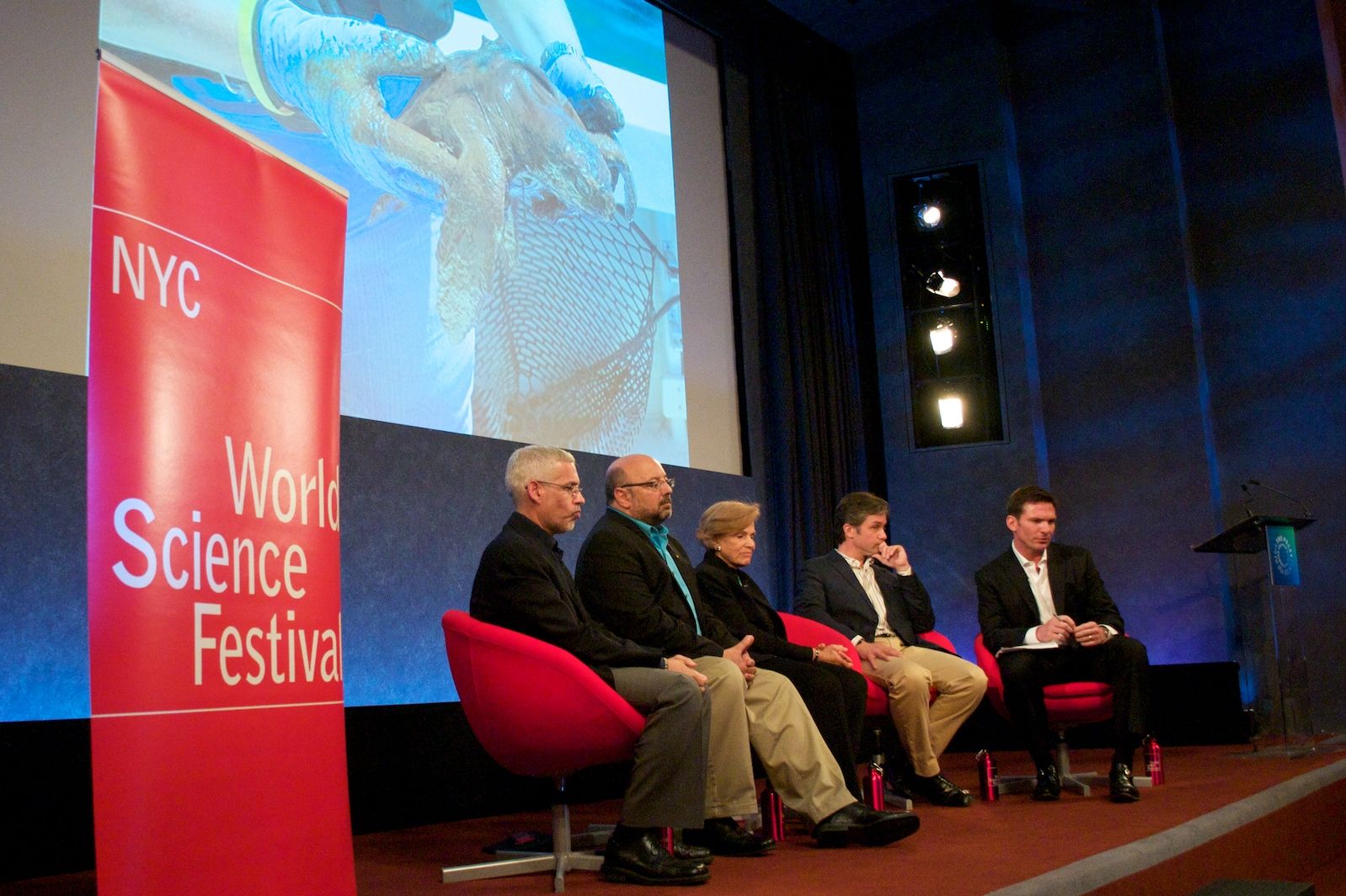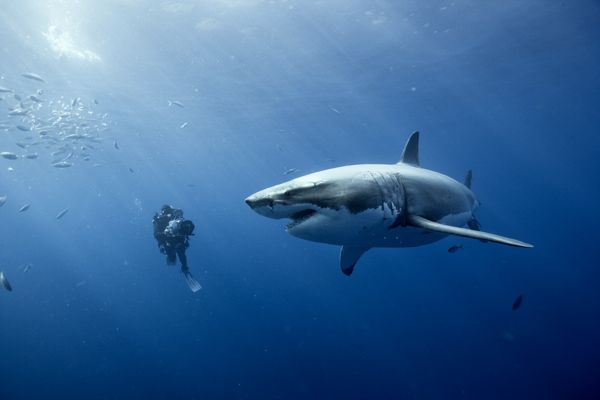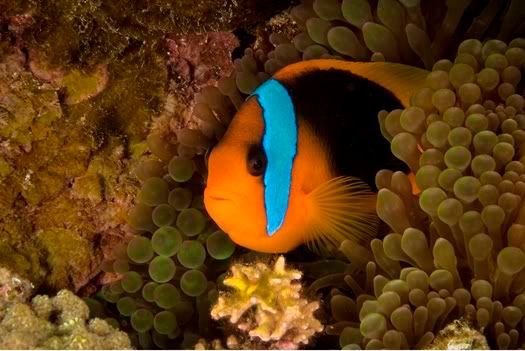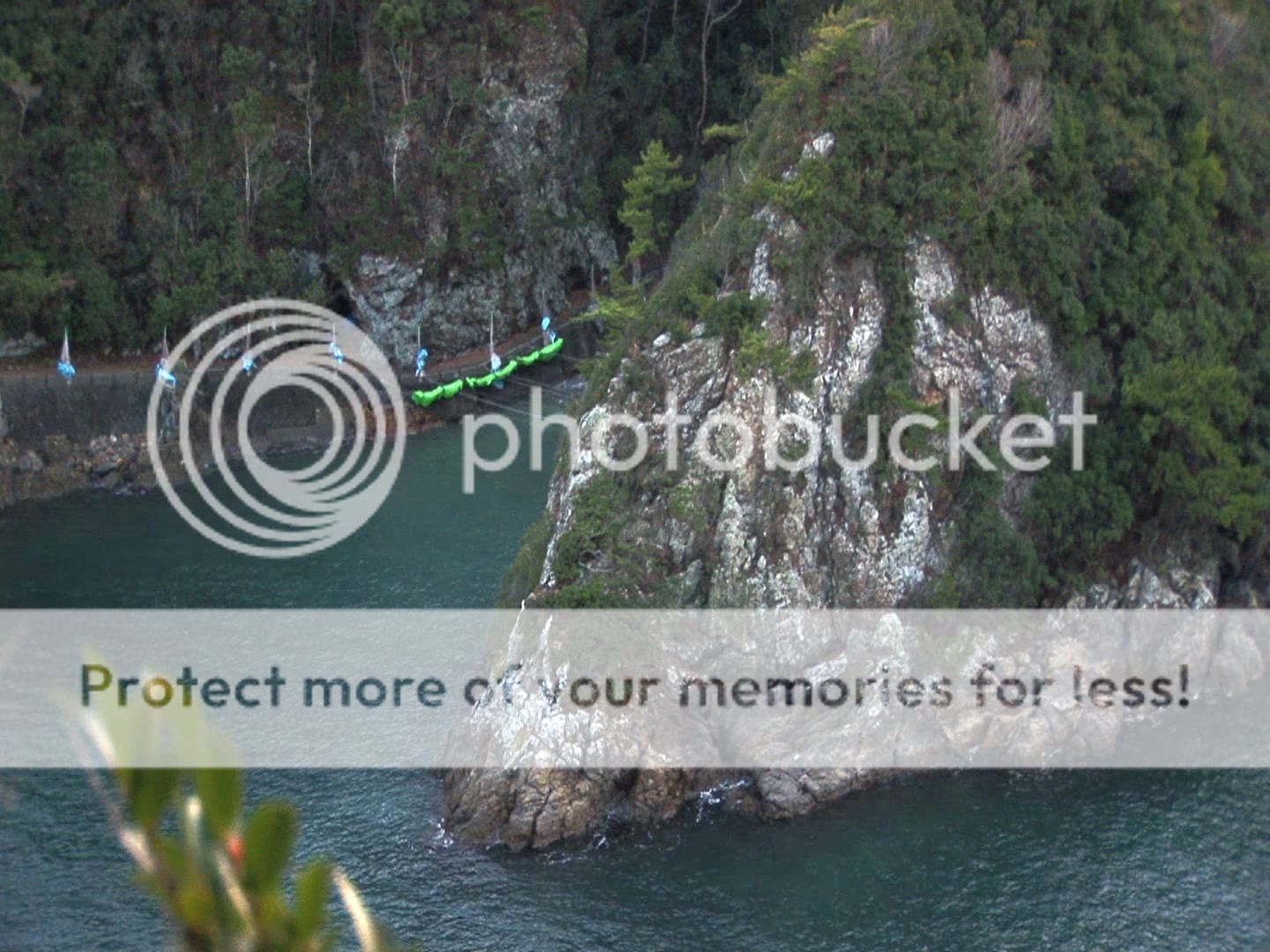
We have truly saved the best for last! ScriptPhD.com’s coverage of the 2010 World Science Festival in New York City concludes with panels ranging from the secrets hidden in our underwater oceanic wonderland (especially apt as we clean the worst oil spill in history), a panel on the hidden dimensions of our visual world, and a behavioral panel that sheds light into how animals and humans process thought. In addition, we provide a short video of star-gazing New Yorkers who came out to see the James Webb telescope last week. Our correspondents were the amazing New York City science writers Jessica Stuart and Emily Elert. Synopses and pictures of three extraordinary panels with the premier scientists of our time under the “continue reading” cut.
ILLUMINATING THE ABYSS: The Unknown Oceans — June 5, 2010
Under our oceans lie mountains many times higher than the Alps, valleys far wider than the Grand Canyon, countless volcanoes, and the largest waterfall in the world. There are thousands of species down there – the current known number is estimated to be around 230,000, but it could be as many as three times that, according to the Census of Marine Life. The oceans drive our climate and weather, and generate nearly 70% of the oxygen in our air. The one thing that life cannot exist without is water, and yet, we treat our oceans “like an infinite resource and a garbage can.”
A packed house gathered Saturday afternoon at the Paley Center for Media, for the panel Illuminating the Abyss: The Unknown Ocean. Jacques Cousteau’s grandson, Fabien Cousteau, a passionate ocean explorer in his own right, along with scientists Sylvia Earle, David G. Gallo, and David E. Guggenheim were the panelists, with moderator Bill Weir. Though the topics were diverse, ranging from the oil spill to personal submarine devices to unsustainable fisheries, all reverted back to the fact that we have so much left to learn about our oceans, and are destroying them more and more each day.

The presentation started with a tribute to Jacques Cousteau, perhaps the most famous explorer of our oceans. His films and adventures have inspired generations to take to the oceans to try to learn and preserve this most unique ecosystem. Unfortunately, this research is woefully underfunded – in the last 50 years, we’ve sent 12 men to the moon, but only 2 to the deepest reaches of the ocean. This lack of knowledge about the conditions and ecosystem in our waters is a big problem, especially given the current state of affairs in the Gulf of Mexico. As of Saturday, almost two million gallons of chemicals had been dumped in the Gulf to try to disperse the Deepwater Horizon spill. Earle called this action appalling, saying we “should not be pouring toxic chemicals into the sea without knowing the consequences.”
Guggenheim is also distraught by the spill. He studies the coral reefs in Cuba – nearly pristine reefs, with healthy ecosystems, that researchers were hoping would give us clues into why so many other coral reefs around the world are dying. Now, with the oil headed that way, they may not get the answers they’re looking for. Enough damage will be done in the Gulf alone, but if the Gulf Stream picks up the oil and circulates it down past the Cuban reefs, then up along the Atlantic coast and over to Europe, we’re looking at a problem of such magnitude that we won’t even know the full impact for many years.
Aside from the tragedy of the oil spill, we do constant damage to our waters through unsustainable fishing. Earle maintains that there is no such thing as “sustainable” commercial fishing. Guggenheim pointed out that we “manage” our fisheries as if they’re crops, like corn, that just grow each year, and we continue to harvest in greater numbers than the sea can replenish. There are proposals in the works to create AquaCulture – land based systems that could create a sustainable industry. Systems are already working in Asia, Australia, and Europe, and could be beneficial in areas like the Gulf, providing jobs and a big investment for the future to those who make their lives in the now decimated fishing industry. Aside from that, we have to start managing our oceans as an entire ecosystem, not as unrelated species that we just pluck out of the water and put on our plates. We don’t fully understand how everything is connected, but we know that if we continue to eat the large predators, like tuna and sharks, we’re creating an untenable long-term situation.
Fabien Cousteau said it best, succinctly reminding us that “There is no Planet B.”
To preserve our oceans, we must first learn more about them in-depth. To learn more, visit:
Mission Blue
Plant A Fish
Ocean Doctor
In addition to our written coverage of the 2010 World Science Festival, ScriptPhD.com took to the streets of New York City with a camera at the star-gazing event in Bryant Park last week. Dozens of amateur star-gazers gathered around the James Webb telescope on display, and we caught up with them to talk about what astronomy meant to them and why they were there. For a genuine feel of the Science Festival vibe, take a look at this video by Jessica Stuart:
Jessica Stuart is a writer, photographer and videographer living in New York City. Find her on her personal blog, and Twitter.
HIDDEN DIMENSIONS — June 5, 2010

“This is really about going beyond our senses,” said Brian Greene from the stage at “Hidden Dimensions,” an event at the World Science Festival Saturday night. The screen behind him (picture below) showed a grid of fluorescent lines with loops sitting on top, like rings balancing on a checkered table. The grid represented all of the dimensions we are aware of—the three that make up space, plus time—and the rings represented another, theoretical dimension.

This extra dimension is just one of six or seven that physicists like Greene think exist, though they are too small to be seen or directly detected by scientific instruments. The extra dimensions are a part of string theory, a mathematical idea that unites two conflicting branches of physics—general relativity and quantum mechanics—by proposing that the tiny particles in the universe are all part of miniscule, vibrating strings.
It sounds crazy. But then, so do a lot of things we can’t see or touch or hear. As an example, Greene showed an animation of a flat plane with a cube passing through it. If you lived only on that flat plane, you would see a shape-shifting shadow—a triangle that grows, becomes a square, and shrinks back into a triangle. It would be hard to make sense of, in a flat world, but adding another dimension—in this case, a third dimension, makes the whole picture a lot clearer. But “adding another dimension” to the way we understand the universe is not such an easy thing. Our fourth dimension, time, has been around for a while, but most of us still get a brain-ache from trying to understand what “space-time” actually refers to, or imagining the inside of a black hole.

Linda Henderson, an expert in twentieth-century art who was on the panel Saturday night, pointed out that, when this mysterious fourth dimension first came around in the late 19th century, the concept influenced movements in art and literature. Cubism, she said, is a good example of artists grappling with a new concept. Paintings like Picasso’s “Portrait of D.H. Kahnweiler” demonstrate these artistic wanderings into the new dimension. Though the painting is abstract, it represents a real idea. “It’s a painting that we can’t really say is only three dimensional,” Henderson said.
The invention of the x-ray machine, said Henderson, served as another reminder of the limits of our own senses. Displaying an early x-ray photograph on the screen, Henderson asked, “who can say there isn’t a fourth dimension, just because you can’t see it?”

But Lawrence Krauss, a physicist also sitting on the panel, reminded the audience that ideas in math and art are different from science. “People want there to be more there than meets the eye,” said Krauss. While art and math can explore these ideas, Krauss noted, “there’s a huge difference between math and physics.” In other words, physics—like all science—requires theories to make testable predictions about the world, a hurdle string theory has yet to clear. Krauss recalled the words of Richard Feynman, one of the world’s most beloved physicists: “Science is imagination in a straightjacket.”
The challenge for physicists is to find a straightjacket big enough for string theory. In the meantime, we always have art.
ALL CREATURES, GREAT AND SMART — June 5, 2010
There were five panelists on stage at “All Creatures Great and Smart,” an event at the World Science Festival on Saturday afternoon, and each of them presented ideas that blur the clean lines people have tried to draw between the human and animal mind.
But it was panelists six through nine, with the help of number five, Brian Hare, who stole the show. Hare, an anthropologist, is interested in whether animals can develop theory of mind, the ability to think about what others are thinking about (otherwise known as the “I know you know that I know you know” phenomenon).

Humans aren’t born with theory of mind, but they develop it at a very young age, said Hare. “By the time your kid is four, they’re very good at deceiving you,” a clear sign that they can think about which facts you may be keen to—and which you may not be.
As a graduate student, Hare performed an experiment with chimpanzees, using the same type of test used by child psychologists. He put two containers upside-down on the floor in front of each chimp, hid food under one (children get toys), and then signaled the food’s whereabouts by pointing, standing closer to one bucket than the other, etc.
The chimps did not take the hint. They did not, it seems, have theory of mind.
Then, Hare began to think about how good his dog was at following social cues (and using them to its advantage), and decided to try the same experiment with dogs. His advisor was at first skeptical. “He said, yeah, yeah, everyone’s dog does calculus,” Hare remembered. But Hare ended up conducting his experiment, and on stage at the World Science Festival, he offered to repeat it with four volunteers. The first three dogs, Bela, Sammy, and Molly, were angelic subjects; they sat upon instruction, and awaited permission to retrieve a piece of cheese that Hare laid down a few feet away.

And when Hare put a piece of cheese under one of the buckets and then pointed to it, the dogs followed the cue immediately.
This spotless confirmation of Hare’s canine-theory-of-mind was tarnished, however, by the fourth subject, a spirited Burmese Mountain dog named Georgie. It wasn’t that she couldn’t follow cues—she simply took a first-come, first-serve approach to the treats, preventing Hare from testing his hypothesis. As Georgie’s owner pulled the reluctant pet from the stage (she wanted to stay with the cheese), Hare pointed out that Georgie had gotten everything she wanted while on stage.
Which, at the end of a show about how animals are like humans, left me wondering how much humans may be like animals: are we all either blunt or clever?
Emily Elert is a freelance science writer living in New York City. Follow her on Twitter.
Follow the World Science Festival on Facebook and Twitter. All photography ©ScriptPhD.com. Please do not use without permission and credit.
*****************
ScriptPhD.com covers science and technology in entertainment, media and advertising. Hire our consulting company for creative content development.
Subscribe to free email notifications of new posts on our home page.
]]>
Happy Earth Week 2010, everyone! Here at ScriptPhD.com, we have devoted a number of articles to environment, sustainability and eco-awareness as part
of our continuing “It’s Not Easy Being Green” series. This year, in celebration of the 40th anniversary of Earth Day, we are devoting the entire week to articles, interviews and profiles of companies, individuals and content that raises awareness of sustainability efforts and new ideas for the green science revolution. Because water lies at the heart of most modern environmental crises, we kick off Earth Week with CaptainPlanet’s review of the stellar new DisneyNature documentary Oceans, a truly spectacular oeuvre that celebrates the majesty of our most important and delicate resource. We also include a number of practical, easy things you can do right now to make a difference globally by acting locally. For our Oceans review and to find out what you can do to help protect our Earth’s water supply, please click
the “continue reading” cut.
When I was three years old, my parents took me on a vacation to Atlantic City. It was my first time ever to see the ocean, and my parents were excited to see my reaction at seeing the water when we arrived at the beach that morning. Although I don’t remember the experience, I’ve been told that when I first set foot on the beach, I had a very concerned look on my face when I saw the waves pounding the shore. I ventured closer to the water to get a closer look, and upon surveying the incoming waves, I promptly turned on a dime and outran my parents back to the hotel without stopping. When my parents finally caught up with me to find out the reason for my distress, I said, “the river came out of itself,” in awestruck horror at the ocean’s power.

Oceans, a DisneyNature documentary premiering in theatres on Earth Day, April 22, 2010, opens on a similar theme of childhood wonder as a little boy on a beach stares out at the vastness of the ocean before him and wonders what an ocean is. As children, before we learn names for what things are called, and prior to learning about taxonomical categories in biology courses, staring at an ocean and all of its inhabitants is truly an exercise in wonder. Oceans ignites that childlike wonder while exploring the richness, beauty, danger and primordial nature of the sea. Directors Jacques Perrin and Jacques Cluzaud clearly have a knack for inciting wonder. Perrin directed the acclaimed The Winged Migration in 2001 and Cluzaud’s resume features work in IMAX films and innovative projection techniques.
Disney launched the DisneyNature label after the worldwide success of March of the Penguins in 2004. Their mission is to release one nature-related documentary per year to raise awareness about the interconnectedness of humans and nature, including what actions we can take to positively impact the environment. It is promising to see a global media corporation as hefty as Disney champion sustainability in a serious way. And it will be clear to anyone who sees Oceans, a top-notch production with stunning cinematography, narration and musical score, that Disney spared no expense to produce this film.
Pierce Brosnan, the film’s narrator, seems to have found a daft second career in narration, starting with his excellent work on the pre-recorded audio tour of the 2006 Magritte exhibit at the Los Angeles County Museum of Art. Brosnan’s voice, retaining the suaveness of his 007 days, guides us on a journey through waters of the globe. It seems at times as though the film has managed to capture every single creature that inhabits the oceans, as impossible as that would be. From whales, dolphins, sharks, sea lions, polar bears, otters, fish, crabs, shrimp, plankton, turtles, to penguins, octopi, jellyfish, and many more, it’s easy to forget just how many members of the animal and plant kingdom reside
in the oceans.

In one of the film’s most breathtaking sequences, we witness a school of sardines massacred from above and below by an army of birds, dolphins, sharks and blue whales. The sequence is an orgiastic feeding frenzy, shot from above, on the surface and underwater, accompanied by a kinetic musical score. The different animals in this sequence appear so choreographed that they invoke the ballet of dancing hippos, ostriches and alligators from the “Dance of the Hours” sequence from Disney’s animated Fantasia masterpiece. The sequence ends with a blue whale breaching the surface in the center of concentric rings of dolphins, fish and birds, a prima ballerina taking her bow.
Oceans is primarily a love letter to our world’s oceans, surveying the various topographies and lifeforms of the world beneath the surface that we often take for granted. Fortunately the film doesn’t shy away from discussing the danger that human activity poses to oceans. Although Oceans was never intended to be a hard-hitting piece of environmental journalism, it does strike a good balance between education and advocacy. The film highlights how advances in satellite imagery allow us to see where industrial pollution flows from rivers out into the open ocean, much the same way a calcified artery might appear on a heart scan. In a regular satellite photo, the river appears to be as blue as the ocean, but when the view switches to the new technology, the pollution in the river, heretofore unseen, materializes in the photo as a black, foreboding stream. The oceans have become humanity’s dumping ground for hundreds of millions of tons of trash each year. In another sequence, we see gigantic fishing nets that sweep vast swaths of water, a practice known as trawling, decimating global fish populations and killing other animals unlucky enough to get caught in the vast net. And in Antarctica, we are shown how rising global temperatures have resulted in the demise of the polar ice caps. Though the film doesn’t broach the topic directly, human water consumption is another imminent crisis facing our oceans. In a brilliant editorial, National Geographic Society chairman Gilbert Grosvenor discusses how human water usage is unsustainable and touts a National Geographic issue devoted entirely to water. (Download here.) Towards the end of Oceans, Brosnan boldly (and correctly) states that the greatest threat to the ocean is human indifference. We hope that you attend, absorb and engage in activism, even at the most basic levels to prove him (and all of us) wrong.
Coinciding with the film’s release, Disney has launched a campaign, in partnership with The Nature Conservancy, to create a protected area of coral reef in the Bahamas. Each moviegoer who attends an Oceans screening in the first week of the film’s release will help contribute to the cause. The campaign for the previous DisneyNature release, Earth, resulted in the planting of an astonishing 2.7 million new trees in the Amazon rainforest. The Nature Conservancy, founded in 1951, protects more than 119 million acres of land, 5,000 miles of rivers, and 100 marine conservation projects globally. With a staff of more than 700 scientists, they pursue their goals through science-based, non-confrontational strategies.
Oceans Trailer:
Oceans goes into wide release on Earth Day, April 22, 2010 at theatres nationwide.

•Contact your congressional representatives to voice your support for the Oceans-21 Act: a bill that adopts the key recommendations of the U.S. Commission on Ocean Policy and the Pew Oceans Commission to develop a holistic ocean health plan. This bill, unlike past ocean legislation, treats the disease, not the symptom.
•Educate yourself about the sustainability of seafood. Check out “Bottomfeeder: How to eat ethically in a world of vanishing seafood” by Taras Grescoe.
•Check out the Monterey Bay Aquarium’s guide to seafood
•Volunteer or donate to ocean related organizations. If you live by a coastal area, attend a beach clean-up.
•If going on a cruise, choose an environmentally friendly cruise line
•Support elected officials who support the ocean.
•Keep trash out of the oceans—if you don’t already, recycle, reduce, reuse and compost as much of your waste in your home and office as possible. Earth911.com is an exceptional resource for tips on recycling, finding ways to be greener, reduce waste, and purchase products made of recycled materials.
•Have more ideas for us? We’d love to hear about them in our comments section.
CaptainPlanet is an LA-based, Northwestern University-educated, eco-charged sustainability guru who loves film, psychology and saving the planet, one waterless urinal at a time…
~*CaptainPlanet*~
*****************
ScriptPhD.com covers science and technology in entertainment, media and advertising. Hire our consulting company for creative content development.
Follow us on Twitter and our Facebook fan page. Subscribe to free email notifications of new posts on our home page.
]]>
One of our most exciting continuing projects here at ScriptPhD.com is our “It’s Not Easy Being Green” series of articles, highlighting the environmental and green issues and technology solutions facing our time (see our recent Blog Action Day post). Dedicated to bringing you more in-depth and frequent green content, we are thrilled to add a new ScriptPhD contributor, CaptainPlanet, who will write exclusive movie reviews and issues for “It’s Not Easy Being Green.” He joins us with a review of The Cove, a recent documentary garnering Oscar buzz, about the secret dolphin-hunting industry in Japan and its environmental and emotional impact. If you hadn’t previously known about how majestic and advanced dolphins really are, and how deleterious the depletion of fish is across the oceanic biosphere, watch this film. ScriptPhD.com review, discussion, and ways to get involved, under the “continue reading” jump.
REVIEW: The Cove
ScriptPhD.com Grade: A
The biggest problem with The Cove, a 2009 documentary in serious contention for the Oscar, is how to describe the film in one sentence to someone without dampening their enthusiasm for wanting to see it. “It’s a movie about dolphin slaughter,” summarized director Louie Psihoyos at a recent screening in Los Angeles. The Cove is about so much more than dolphin slaughter, the filmmaker went on to say, but when you try to sum it up to someone, you’ll find yourself saying that phrase again; dolphin slaughter. Try persuading your friends and co-workers to go see a truly great film about, say, puppy murder, and you’ll soon discover the problems inherent in generating good word-of-mouth for The Cove. The good news is that the Cove is a breathtakingly good film; a suspenseful adventure in the vein of Ocean’s 11 about a small group of concerned individuals who literally risk their lives to blow the lid off of Japan’s black market of dolphin capture, killing and consumption.
The story of The Cove must be traced all the way back to 1963 with the mother of all dolphin movies, Flipper. NBC created an eponymous television series that aired from 1964 to 1967. The part of “Flipper” was played by five live female dolphins, under the supervision of one of the world’s first dolphin trainers, Richard O’Barry. One of the lead dolphins, Kathy, was sold to a major American aquarium after the series wrapped. Years later when O’Barry went to visit Kathy in her tank, he could tell that she was depressed. Kathy swam up to him, gave him a “hug,” and then turned around and committed suicide. As The Cove explains, human beings breathe automatically, but dolphins must consciously choose every breath, giving them the ability to end their own life if their conditions become unbearable. O’Barry watched Kathy’s body sink to the bottom of the tank, stunned by what he had just seen while also feeling guilty that he had not done more to lobby for her return to the wild. The next day, O’Barry was arrested at an adjacent aquarium while attempting to free another captive dolphin. Thus, an activist was born. To present day, O’Barry has dedicated his life (and sometimes risked it) to freeing captive and distressed dolphins in locations around the world, including a deceptively beautiful looking cove in the small fishing town of Taiji, Japan. He is the author of two books on dolphins, To Free a Dolphin and Behind the Dolphin Smile. For his lifetime of activism and environmental contributions, O’Barry has been a previous recipient the Environmental Achievement Award presented by the United States Committee for the United Nations Environmental Program.

Every year from September through March, tens of thousands of dolphins migrate past Taiji, Japan, where fishermen force the animals into a cove using nets and loud noises produced by banging on underwater pipes with hammers (since dolphins’ primary communication is by sonar, they are hypersensitive to noise). To escape the noise, the dolphins swim into the cove where they are trapped. From that point, the dolphins face two scenarios: being sold into captivity or being killed for lunch meat. Each year 23,000 dolphins are killed in Taiji alone. Japan is a nation that relies heavily on seafood as a food source, and it is not uncommon to see whale and dolphin meat for sale in Japanese food markets. In one scene, the filmmakers visit the seafood section of a Japanese market. They pick up pieces of meat cushioned in white Styrofoam wrapped in cellophane from a refrigerated bin. Upon closer inspection, we see that the meat in the container is an exotic dark purple color, and when the camera zooms in to capture the label, we see that the food in hand is a piece of dolphin flank. Other meats masquerading as expensive, rare seafood were analyzed by the filmmakers in a makeshift DNA lab and also found to be dolphin. A 2006 US Geological Survey report showed that oceanic mercury levels were 30% higher than in the mid-90s. Because of this, mercury levels have been steadily rising in fish meat, but some fish contain higher levels than others. Fish that are predatory (eat other fish) are large and at the top of the food chain, and so tend to contain more mercury. Dolphins fit into this category.
For years the ignominious fate of dolphins at Taiji has gone unnoticed because there is no documented footage of the capture and slaughter, mostly due to a carefully orchestrated media blackout. Most Japanese citizens in major urban centers, as The Cove is quick to point out, are not even aware that their country participates in harvesting dolphin meat for consumption. O’Barry discovered the cove at Taiji years ago and has since spent many years trying to save the dolphins from capture or death. His efforts have been thwarted time and time again by the local Taiji government, intense security surrounding the cove and blatant hostility (including bodily harm) from the Taiji fishermen. The Cove conveys beautifully how much being an environmental activist like O’Barry is dangerous work. One of O’Barry’s colleagues, Jane Tipson was mysteriously shot to death while protesting the Caribbean nation of St. Lucia for its lucrative swim-with-dolphins program. The stakes are high for dolphin activists because the dolphin trade is a billion dollar industry. A live dolphin sold from the cove in Taiji brings in a six-figure sum for the fishermen.

O’Barry realized that the only way to stop the dolphin slaughter in Taiji was to somehow capture video footage of the killings in order to create a public relations nightmare for Japan in the hopes of bringing an end to the practice, which, after an informative primer into the dolphin hunting practice, is where the movie’s plot really takes off. The makers of The Cove assembled a crack team of marine, surveillance and security experts to break into the cove and capture the grizzly footage that would ultimately be the dolphin’s best hope of survival. How and if they were able to pull it off is one of the film’s most delightful and suspense-filled elements. In the screening that ScriptPhD.com attended, audience members were actually yelling at the screen as they would at a character in a scary movie for being so dumb as to go outside to investigate a mysterious noise.
It is true that The Cove is about so much more than dolphin slaughter. It’s also about the thrill and hardship of environmental activism, the politics of the corrupt international whaling society, the impact of Western imperialism on Japan’s identity as a nation-state, the growing threat of mercury poisoning due to contaminated seafood and the general demise of Earth’s oceans at the hands of humans. But most of all, The Cove is about human’s fascination with the dolphin, a highly intelligent, arguably self-aware creature that can defy the laws of physics for its speed and grace in the water. A surfer (turned dolphin activist) describes being saved from a tiger shark by an altruistic dolphin off the coast of Australia. Reports of dolphins saving humans from sharks and drownings are very common throughout modern history. In a stunning, harrowing 2007 tale of survival, surfer Todd Endris, badly mauled by a great white shark, was saved by an insulating ring of bottlenose dolphins until the shark went away. In ancient Greece, it was actually a crime punishable by death to harm a dolphin. Why there are humans that insist on brutally killing these otherworldly creatures and why concerned citizens the world over have been unable to prevent the slaughter is an intriguing issue that The Cove explores with insight and compassion.
Like many good documentaries of recent years, The Cove was financed and made by activists. This year, the very popular Food, Inc. combined compelling storytelling with an urgent message about the need to reform an existing infrastructure. The Cove demonstrates that the judicious application of restraint goes a long way in changing hearts and minds. In one memorable scene, while interviewing a Japanese bureaucrat who defends the practice of killing dolphins, the filmmakers ask to take a sample of his hair to test it for mercury poisoning (some samples of dolphin meat have shown mercury at more than 1000 times the maximum allowable levels). It’s hard to imagine an audacious filmmaker like Michael Moore putting his opponent in checkmate in a way that doesn’t feel like a body slam, but the makers of The Cove manage it quite well throughout the film. And whereas Food, Inc. stopped short of showing graphic footage of animal slaughter, even though if such imagery would have done more to expose the ugly underbelly of factory farming, The Cove offers no such palliative censorship. By the end of the film, having brutally witnessed the process of how dolphins are trapped and killed, there is literally blood in the water.
A hit on the festival circuit this year, The Cove has already achieved some key milestones in putting an end to the dolphin business in Japan. This year in Taiji, due to pressure on the town from the film’s success, bottlenose dolphins were spared from being slaughtered. But the less popular spinner dolphins were not. The town members of Taiji are now undergoing mandatory mercury testing, and the media blackout of the dolphin killings has come to an end. Where the film will go from here is anyone’s guess. Its imminent release on DVD will help the issue resonate with wider audiences. An Academy Award nomination or win could take the film to a whole new level of exposure worldwide. As the filmmakers slyly reminded us during their Q&A, the Oscars are one of the most watched television programs in Japan.
The Cove is out on DVD and Blu-Ray December 08, 2009.
Trailer:
What can you do? First and foremost, watch the movie. Buy or the DVD, and contact the film’s press department to schedule educational, campus, museum, church, and group screenings. Nothing can match the emotional impact of witnessing the dolphin slaughter and learning the cold facts surrounding the environmentally catastrophic seafood depletion and escalating mercury poisoning. Secondly, inform yourself. Visit one of these sites to explore the issues and what you can do about them:
•Mercury poisoning facts Learn the facts about fish and mercury levels
•Article on fish depletion and a recent Science paper that posits near-total seafood depletion by 2048.
•Save Japan Dolphins, Ric O’Barry’s organization
•Oceanic Preservation Society, established by director and former world-renowned National Geographic photographer Louie Psihoyos
•The Cove Social Action Site, with links to write to leaders and other steps you can take
Finally, spread word and donate your time or money. It can make a huge difference. Take a look at this brief video by dolphin activist Rick O’Barry, along with some of the links we have provided above, and please take action today!
CaptainPlanet is an LA-based, Northwestern University-educated eco-charged sustainability guru who loves film, psychology and saving the planet, one waterless urinal at a time…
~*CaptainPlanet*~
*****************
ScriptPhD.com covers science and technology in entertainment, media and pop culture. Follow us on Twitter and our Facebook fan page. Subscribe to free email notifications of new posts on our home page.

